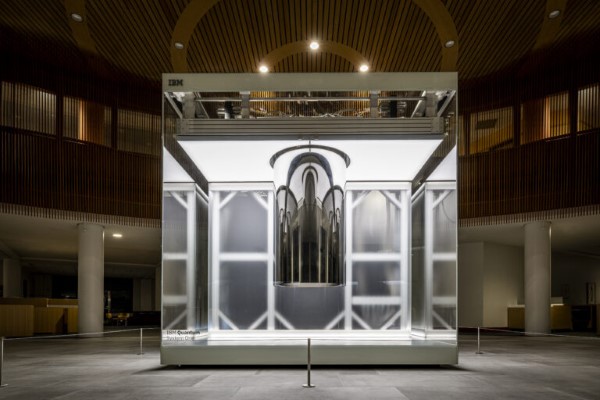Alifesaving image is one worth capturing.
When top management at Quality Electrodynamics (QED) and the Cleveland Clinic Hillcrest Hospital informed Dr. Hiroyuki Fujita of issues faced when utilizing current imaging technology, he knew the only way out was through. But, not without some innovative collaboration.
In 2006 Dr. Fujita founded his Ohio-based magnetic resonance imaging (MRI) technology company QED, which just 13 years later became a subsidiary of Canon, Inc. Today, he still acts as CEO of QED, and as of 2020, additionally serves as Chair of Cleveland Clinic Hillcrest Hospital’s Board of Trustees. As conversations swirled around how to address future technological needs, he had imaging expertise in mind.
Canon was fresh off the heels of establishing its new health care subsidiary, Canon Healthcare USA, Inc., in Mayfield, Ohio, in 2023. The official announcement noted “potential synergy with the Cleveland Innovation District was one factor that attracted Canon,” not knowing the perfect opportunity would arise faster than anticipated.
Canon soon joined forces with Cleveland Clinic with plans to introduce a new comprehensive imaging research center, bringing new advancements to the heart of the Cleveland Innovation District. The establishment of this facility on Cleveland Clinic’s main campus will look to draw in local and global research collaborations to work alongside a team of clinician scientists, researchers and engineers.
“Cleveland has a long history of medical innovation and is the home to leading medical institutes such as Cleveland Clinic and University Hospitals,” says Canon spokesperson Ryan Herling. “Cleveland is close to other regions that have led medical innovation, such as Boston, New York and Chicago. Canon has had a historical presence in Cleveland through its Canon Medical Research USA, INC. (CMRU) and Quality Electrodynamics (QED), allowing us to leverage our long-established presence in the region.”
Cardiology, neurology and musculoskeletal medicine serve as the main imaging technology focus, looking to enrich a patient’s experience with diagnosis, care and outcome.
R&D efforts target non-invasive imaging and health care IT technology for pre-clinical imaging, human imaging and image analysis.
“We plan to conduct research on all of Canon’s imaging modalities, including CT, MRI, ultrasound and X-rays,” says Herling. “The research content will be determined after discussions with Cleveland Clinic. Under Canon’s ‘Made for Life’ philosophy and Cleveland Clinic’s ‘Patients First’ principle, we are dedicated to improving the well-being of people around the world through our innovations in technology.”
From Concept to Fruitful Innovation
It’ll be worth keeping an eye on the innovative healthcare technology research taking place on Cleveland Clinic’s campus moving forward, thanks to a fresh batch of new companies equipped with new-age knowledge that can only be accessed in Ohio.
The new initiative joins the activity surrounding IBM’s Quantum System One, which launched in May 2023. It’s the world’s first quantum computer for biomedical and health research, harnessing quantum mechanics to solve problems where current supercomputers falter. Innovation begets further innovation, which is why the inaugural Cleveland Clinic Quantum Innovation Catalyzer Program is leveraging this asset to spark life in early and growth stage startup companies.
In April 2024, following a competitive selection process, a number of companies were announced as the first to begin the 24-week program. Unlike any startup program available in the world, these participants can conduct individualized research with access to IBM’s Quantum System One, work alongside the clinic’s base of clinicians and investigators, attend any number of educational program offerings and network with investors and ecosystem partners.
Access to Quantum System One also affords the opportunity to collaborate with and learn from the research team within the Cleveland Clinic-IBM Discovery Accelerator. The 10-year partnership focuses on an array projects across four categories — education and research, quantum computing, accelerated discovery and digital health — aiming to revolutionize how AI and quantum computing can impact the development of new technologies and treatments.
 IBM and the Cleveland Clinic are sharing the strengths of Quantum System One through a new program.
IBM and the Cleveland Clinic are sharing the strengths of Quantum System One through a new program.
Photo courtesy of IBM
“Through the Discovery Accelerator, Cleveland Clinic and our partners at IBM are exploring quantum computing’s vast potential to transform medicine, from drug discovery to digital health and biomarker analysis,” said Cleveland Clinic Chief Research Information Officer Lara Jehi. “We look forward to welcoming the first class of startups to our new Cleveland Clinic Quantum Innovation Catalyzer Program and helping them to leverage quantum to make breakthroughs in health care as we grow an ecosystem of advanced computation for health care and life sciences.”
What’s Next?
The collaborations taking place across Innovation Districts in Columbus, Cleveland and Cincinnati are indicative of the network of support that exists throughout Ohio.
Entrepreneurs and innovators at any stage of development don’t have to search far to find the resources needed to grow their capabilities. JobsOhio’s Network of seven regional economic development partners — Dayton Development Coalition, Lake to River Economic Development, Ohio Southeast Economic Development, One Columbus, REDI Cincinnati, Regional Growth Partnership and Team Northeastern Ohio (NEO)— work together to ensure any venture is a successful one.
But one size does not fit all when it comes to operating a business. Based on individualized site, infrastructure, talent and funding needs, a company can streamline its exploration of the state and what each region can offer through this tightknit network.
The addition of the Lake to River Economic Development team in April 2024 cemented the final missing piece of the JobsOhio network. This region, encompassing eastern Ohio counties Ashtabula, Columbiana, Mahoning and Trumbull, plus Pennsylvania’s Mercer County, adds a competitive workforce edge, supported by its cluster of leading state institutions, like Youngstown State University.
“Today, we welcome the Lake to River team to join Team Ohio as our seventh and final JobsOhio network partner,” said JobsOhio President and CEO J.P. Nauseef as he welcomed the new team. “Since 2011, JobsOhio and Team NEO have been building momentum for the region, which has led to more than $6 billion in capital investment; we are eager to get to work with our new partners to continue building a bright future for the valley.”
The goal? Get innovators off the ground and bolster further growth. One avenue early-stage companies can explore through each regional network partner is obtaining a JobsOhio Growth Capital Fund investment. For companies looking for their start in the state, the co-investment fund caters to candidates with a lead investor looking to raise a Series A or later round of funding within Ohio’s target sectors.
The program offers a 1:1 investment match to the lead investor’s committed amount and can take up to 20% of the current investment round as a sidecar investment.
The program has produced a roster of innovative companies now operating throughout the state, including Amify, Centerline Biomedical, eFuse, Orthobrain and Vantage Robotics.
As long-established companies such as Honda, J.M. Smucker and Bullet Ultrasonics look to foster R&D across leading state industries such as automotive, food and beverage and advanced manufacturing, having a central location to gather innovators is vital to Ohio’s economic development playbook.
Much like the health care innovation activity surrounding the Cleveland Innovation District, JobsOhio is set to aid the development of new R&D centers. With $100 million in hand, the R&D Center Grant Program awards funding to corporates with more than five years of operating experience and over $10 million annual revenue to establish a new R&D facility.
To qualify, the project must represent at least $3 million in new cash investment and use funding to cultivate fresh industry-driven research, software development and development of new technologies. Funding will last the course of five years and must result in the creation of at least five new jobs.
New project investment in the state over the past decade shows that when industry leading companies are looking to advance their potential, Ohio holds the recipe for success.

